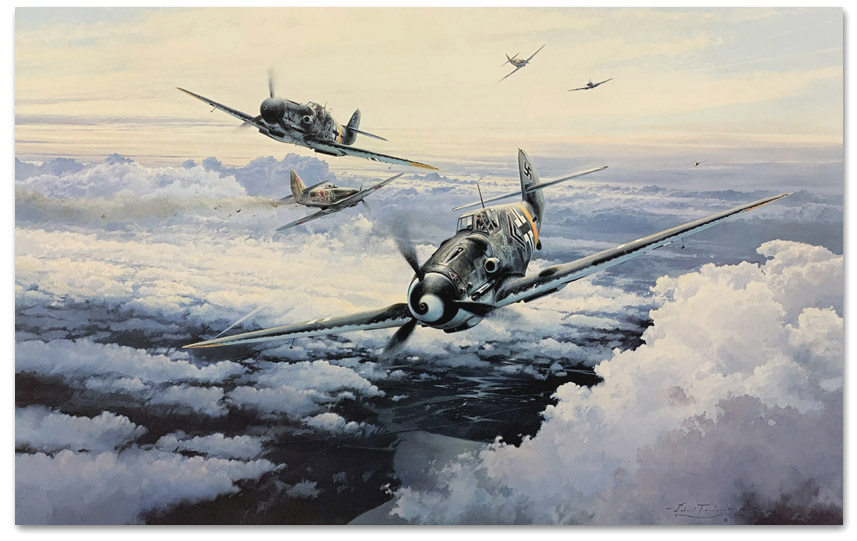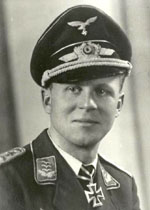

Knights of the Eastern Front
by Robert Taylor
| Featuring Messerschmitt Me109Gs of JG-52, the most successful fighter wing of the Luftwaffe during World War II. Initially based in Germany, the Wing flew against the French before taking on the RAF Spitfires and Hurricanes in earnest during the battle for France and the Battle of Britain. During this intense period of air fighting the Wing lost many pilots and in October 1940 it withdrew to rebuild. After the fall of Crete, JG-52 assumed the first fighter role in Southern Russia and it was on the Russian Front that the Wing's greatest Aces notched up their substantial scores. Though conditions were often appalling, the pilots of JG-52 flew a tremendous number of missions. The Wing lost 678 of its aircrew in achieving 10,000 aerial victories during its campaign, sixty-seven pilots being awarded the Knights Cross or higher decorations. JG-52's top ten scoring fighter pilots achieved an astonishing 2286 aerial victories between them, and the only two Aces in history to destroy more than 300 enemy aircraft, Erich Hartmann and Gerhard Barkhorn, flew in this historic Fighter Wing. Issued in 1992, this piece quickly sold out. To this day no other Robert Taylor print has been more sought after. |
| Overall size: 25" x 34" |
| Secondary market | Signed by seven of the Luftwaffe's most prominent fighter pilots. | $1795 |
| The Signatories |
In October 1942 Hartmann joined 7./JG52 on the Eastern Front and in August 1943, a month when he scored 48 victories, was shot down and taken prisoner, later escaping. In August 1944 he reached 300 victories after downing 11 aircraft in one day, taking command of 9./JG52. Promoted to Gruppenkommandeur of I./JG52 he trained on the Me262 before returning to JG52. |
Günther Rall was a young pilot with III./JG52 at the outbreak of war, and quickly demonstrated his natural ability and leadership qualities. He scored his first victory early in the Battle of France, and by July 1940 was leading 8./JG52. After transferring to the Eastern Front his victories soon mounted but he was hospitalized following a crash. Returning to combat as Kommandeur of III./JG52, he gained the Wing's 500th victory, before being posted Kommandeur of II./JG11 on the Western Front, flying high altitude intercepts in Me109Gs. He was later Kommandeur of JG300, and finished the war as the 3rd highest Ace in history with 275 victories. He was awarded the Knight ’s Cross with Oak Leaves and Swords. |
|
 Dieter Hrabak Dieter HrabakHrabak joined the German navy in 1934. Two years later he transferred to the Luftwaffe, and qualified as a pilot. In 1938 Hrabak was posted to the Vienna Jagdgruppe, I./JG 138. This unit was later redesignated I./JG 76 during the Polish Campaign, before becoming II./JG 54 in April 1940. During the Polish Campaign, Hrabak was shot down (the first of 11 times) on his first mission, making a belly landing. On 13 May 1940, he claimed his first victory, a French Potez 63 and he claimed five more victories before the armistice. During the Battle of Britain, Hrabak flew with of JG 54, becoming Gruppenkommandeur II./JG 54 on 26 August 1940. During the Battle of Britain he added ten victories against RAF fighters and Field Marshal Hermann Göring personally decorated Hrabak with the Knight's Cross of the Iron Cross. Hrabak served in the Balkans campaign and when Operation Barbarosa began in the Soviet Union, he flew on the northern front and over Leningrad. In November 1942, he left JG 54 to become Geschwaderkommodore of Jagdgeschwader 52 . Under Hrabak JG 52 became the highest scoring Geschwader with over 10,000 victories. In August 1943 he got his 100th victory and in November was awarded the Oak Leaves to the Knight's Cross, the 337th soldier to be thus awarded. He had 118 victories. On 20 September 1944, Hrabak scored the last of his 125 victories. In October 1944 he returned to JG 54, serving as its last Geschwaderkommodore until the end of the war. |
Following the completion of his fighter pilot training in Vienna in October 1940, Krupinski was transferred to 6./JG 52. He flew combat missions over France and England and, although frequently in contact with enemy aircraft, did not gain any success. In September 1941, Krupinski was operating over the Eastern front and by the end of the year he had seven victories to his credit. On 25 October 1942, he was shot down in aerial combat and baled out wounded. In May 1943, he was appointed Staffelkapitan of 7./JG 52 based at Taman on the Kuban bridgehead. In August, he recorded 27 enemy aircraft shot down, including his 100th victory on 18 August. Krupinski left JG 52 and Russia on 18 April 1944, with his victory total at 177, to return to Germany and take up command of 1./JG. He gained four further victories with JG 5. Krupinski was transferred again, this time as Gruppenkommandeur of II./JG11 based at Hustedt, near Celle, taking up the post in May 1944. With the Allied invasion of France in June 1944, the Gruppe was rushed to Normandy to operate from makeshift strips on low-level ground support missions. Krupinski claimed a further 10 Allied aircraft shot down before he was wounded on 12 August when exploded motor of his Bf 109 G-5. He suffered burns to his hands and face requiring hospitalisation. Following recovery in hospital, Hauptmann Krupinski was posted to take command of III./JG 26 on 27 September 1944. He claimed his 192nd to 195th victories flying with the unit. He led the Gruppe until its disbandment on 26 March 1945. Krupinski joined Adolf Galland’s ‘of experts’ in JV44. He began training on the Me 262 on 2 April 1945. He was to record at least two victories flying the Me 262. Krupinski ended the war with 197 confirmed victories recorded in 1,100 missions. He had gained 177 victories flying over the Eastern front and 20 over the Western front, including at least two four-engine bomber, eight P-51 Mustang fighters and seven P-47 Thunderbolt fighters. He had been wounded seven times, baled out on four occasions as well as surviving numerous crash landings. |
Johannes Steinhoff enlisted in the Kriegsmarine, where he served for one year alongside his friend Dietrich Hrabak as a naval flying cadet before transferring to the newly reformed Luftwaffe in 1936. There, after completing his training as a fighter pilot, Steinhoff was posted to Jagdgeschwader 26. Later hhe was transferred to 4./JG 52 where he served during the Battle of France and the Battle of Britain and on the Eastern Front where he claimed 28 Soviet aircraft shot down in the first month. In February 1942, as a Hauptmann, he was appointed to command II./JG 52 and claimed his 100th victory on 31 August. He was the 18th. Luftwaffe pilot to achieve the century mark. Steinhoff remained with JG 52 until March 1943, when he took over Jagdgeschwader 77 as Geschwaderkommodore operating over the Mediterranean. On 28 July 1944, Steinhoff received the Knight's Cross of the Iron Cross with Oak Leaves and Swords. He ended the war as a jet pilot, first being posted to Kommando Nowotny in October 1944 and then, with the rank of Oberst, as Geschwaderkommodore of Jagdgeschwader 7 in December. After the heavy losses suffered during Operation Bodenplatte, Steinhoff and other fighter leaders fell into disfavour following the so-called 'Fighter Pilots Revolt' against what was perceived as the incompetence of Luftwaffe high command and Hermann Goering in particular. Along with several others, Steinhoff was relieved of his command for challenging Goering's leadership. After a brief period spent in internal exile, Steinhoff transferred to the Jet Experten unit JV 44 being formed by his close friend and confidant Adolf Galland in early 1945. On 18 April 1945, Steinhoff's Me 262 suffered a tyre blow-out and crashed on take-off from Munchen-Riem airfield. Steinhoff suffered severe burns (spending two years in hospital) which left him visibly scarred despite years of reconstructive surgery. His eyelids were rebuilt by a British surgeon after the war. His wartime record was 176 aircraft claimed destroyed, of which 152 were on the Eastern Front, 12 on the Western Front and 12 in the Mediterranean. He also flew 993 operational sorties. Steinhoff was shot down 12 times but had to bail out only once |
| Receive your print fully framed and ready to display. Please call or email us for a custom framing quote. |




